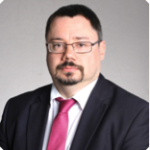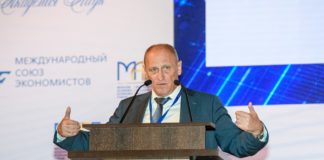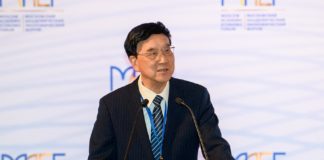How the structure of economy changes.
The absolute majority of websites that are in any way connected with the topic of the National Technological Initiative (NTI) open with the words spoken by President of Russia Vladimir Putin in his 2014 Address to the Federal Assembly: “Based on long-term forecasts it is necessary to understand what challenges Russia will face in 10-15 years, what advanced solutions will be required to guarantee national security, ensure high living standards and industrial development of the new technological order.”
 Maxim Shereikin
Maxim Shereikin
General Director
of the Agency for Technological Development
But how can we take a look into the future of technology, and how the technological order is changing today? Where in Russia is there a demand for advanced technologies? How to bring up a younger generation that will not only enjoy but also create innovations? These questions also have their answers.
The Free Economy talked with the head of the Agency for Technological Development Maxim Shereikin.
National Technological Initiative and other responsible institutions
Free Economy: Maxim Leonidovich, the National Technological Initiative is several years old but not everyone knows what it is and what is has “in store” for our economy?
Maxim Shereikin: For years our government has been dealing with issues related to the development of domestic technologies. The NTI is a very important “key” to this, but it’s not the only one. There are state- controlled financial and venture institutes, holding companies with state participation that develop technologies; and last year the Agency for Technological Development was established. In general, a full-fledged ecosystem is being built that can and will move our economy forward by shaping and consolidating our technological leadership in various industries. The NTI’s main task is “to look beyond the horizon”, into the year 2035. To prepare for the future, to visualize what seems to be the most incredible scenarios. After identifying emerging technological trends in Russia and abroad the NTI is trying to “get hold” of them, to project them into the future. By the way, it is not by chance that one of the criteria for road maps created as part of the initiative was the absence of pre-existing industrial standards — e.g. unmanned vehicles, future nutrition. And the absence of standards is an opportunity to stake out a place for Russia in that landscape.
FE: Sounds good, but will we be able to make all this happen?
MS: If we don’t try, we will surely fail. Therefore, we must by all means work hard to develop future technologies. And we should start now, today, we should take first steps by developing and implementing cutting-edge technological solutions, forming niches, making investments in technology profitable, promising and interesting. Yes, no-one demands future technologies from 2035 from the Agency for Technological Development — simply because no such technologies yet exist. But our logic of working with clients is precisely that while investing in modernization and development it is necessary, among other things, to have industry foresight into the next few years.
FE: And we will then live in an altogether different country?
MS: You know, there is a saying: business plans are not implemented for the sake of their performance but in order to analyze errors. Without a target set in the future, in the year 2035, it is impossible to reach that future.
No, we don’t know what will happen in 2035. But the NTI is not only about technology! Primarily, it is about business models which allow us to create new businesses. In logistics, in health care, in assembly production.
Without moving in this direction, without trying to guess what lies beyond the horizon, we will not be able to reach the future.
Technet, Healthnet, etc.
FE: As of today, do we have any results?
MS: I will speak from the standpoint of the Agency for Technological Development, which today is merely a user of the solutions developed as part of the NTI.
We’ve gotten unambiguously positive results regarding the Technet road map, which is an end-to- end map and is related to all the “rearrangements”. Its results are aimed first and foremost at changing the systems of design, production and operation of products. And in this sense, pilot factories of the future, for example, those created at NPO Saturn, can already be transmitted and passed on further down the chain to those in need of such cutting-edge solutions.
FE: What about the other NTI road maps?
MS: They are more of a sectoral nature, for example, Healthnet, which is aimed at the development of medical technologies. And it is also a significant reference point for the Agency for Technological Development as we are now carrying out a number of projects to transfer technologies in the pharmaceutical sector that are in demand in Russia.
The race will be intense
FE: But the share of innovative products in the total output is a mere 8 or 9 percent and it has not been growing for the last three years. Why is that? Have we forgotten something? Or is it simply too soon, and we’re just poised before the jump?
MS: It’s quite tricky to account for innovative products. They come and go as time goes by.
FE: Perhaps Rosstat should change the accounting system for such products to better reflect them?
MS: That is not a priority. In my opinion, it would be better to hear more about Russian companies that have penetrated completely new segments of the modern marketplace. The more we hear about them, the more evidence we have that the innovative ecosystem is working.
FE: But in order to create these projects, so that their results can be used by ordinary people, a modern of system of education is needed. Education of minds is a slow process. Will we succeed or will it be “catch up and overtake the world” all over again?
MS: It should be admitted that in certain market segments we will, of course, be catching up with the world.
FE: Are those segments critical?
MS: Yes, unfortunately, they are. Microelectronics and instrumentation, for example. But in the big data segment we have a real chance to overtake the rest of the world. And not least because in Russia there is a strong mathematical school, and the Faculty of Computational Mathematics and Cybernetics in the Moscow State University was established in the 1950s.
FE: Will you require any legislative help? Or is the legal base that already exists fully adequate?
MS: Of course we will. I will give an example: we worked on collecting payments on toll roads. Today it is a barrier system with lift-arm barriers. But you can make it barrier-free — by installing a system of optical license plate recognition. At the same time, there is no fine for the failure to pay toll in the Administrative Offenses Code. As a result, investors do not believe that a smart system will help them collect payments, and do not invest in this technology. Because in order to deploy the system they must obtain the right to access our personal data — the traffic police database of license plate numbers.
Yet, driving on a toll road can be several times cheaper. Why? Because the capital and operating costs will be lower — no need to expand roads, create pockets on the road, install barriers, hire cashiers; in the end the traffic capacity will increase which means more revenues from the same road segment.
FE: To summarize, what has the NTI to offer our economy as it exists today?
MS: This question will be better answered by my colleagues from the NTI. But in my personal opinion, we are talking about changing the structure of the economy as such. The more so as the National Technological Initiative road maps are intended for markets with high potential, whose volume should be at least $100 billion by 2035.
Interviewed by Taras Fomchenkov



